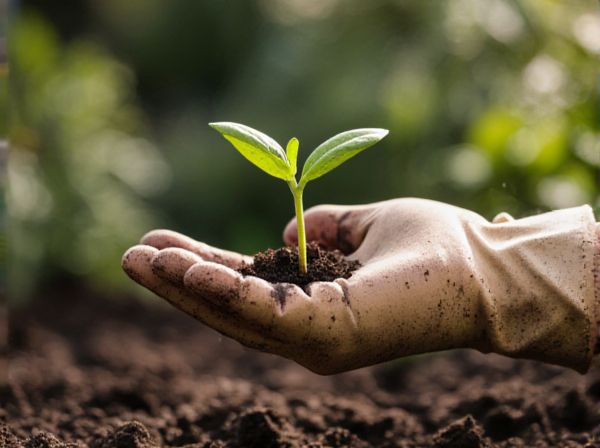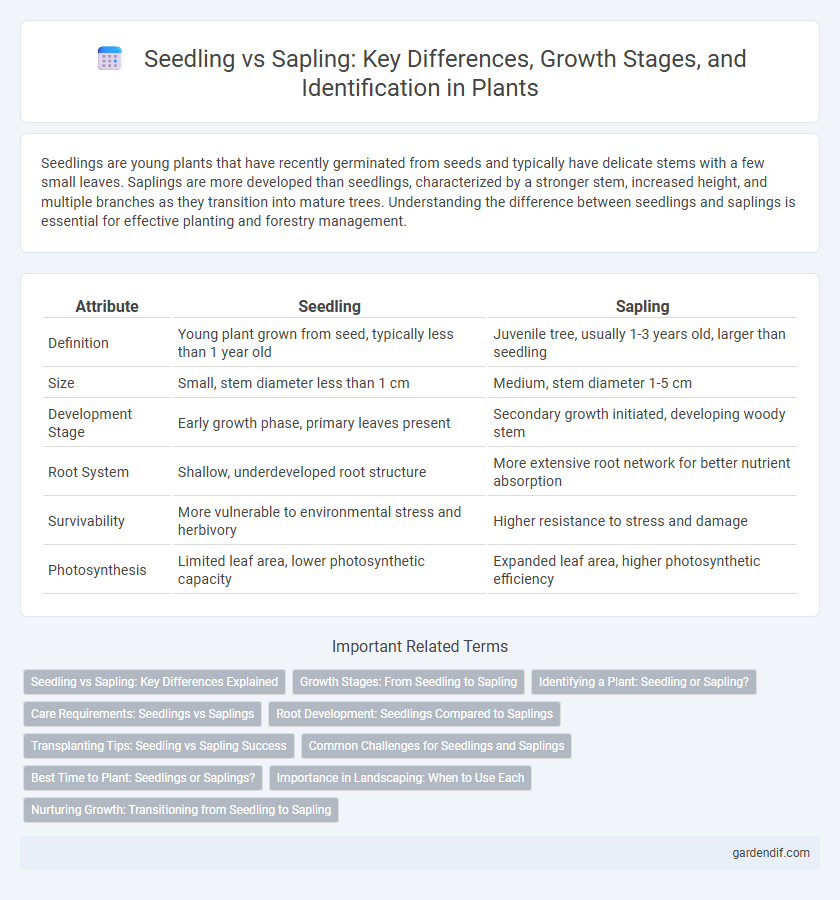
Seedling vs Sapling Illustration
Seedlings are young plants that have recently germinated from seeds and typically have delicate stems with a few small leaves. Saplings are more developed than seedlings, characterized by a stronger stem, increased height, and multiple branches as they transition into mature trees. Understanding the difference between seedlings and saplings is essential for effective planting and forestry management.
Table of Comparison
| Attribute | Seedling | Sapling |
|---|---|---|
| Definition | Young plant grown from seed, typically less than 1 year old | Juvenile tree, usually 1-3 years old, larger than seedling |
| Size | Small, stem diameter less than 1 cm | Medium, stem diameter 1-5 cm |
| Development Stage | Early growth phase, primary leaves present | Secondary growth initiated, developing woody stem |
| Root System | Shallow, underdeveloped root structure | More extensive root network for better nutrient absorption |
| Survivability | More vulnerable to environmental stress and herbivory | Higher resistance to stress and damage |
| Photosynthesis | Limited leaf area, lower photosynthetic capacity | Expanded leaf area, higher photosynthetic efficiency |
Seedling vs Sapling: Key Differences Explained
Seedlings are young plants that have recently germinated from seeds and typically measure a few inches tall with a delicate stem and few leaves, while saplings are more mature, usually several feet tall with a stronger stem and a developing branch structure. Seedlings require careful nurturing to establish roots, whereas saplings are sturdier and can better withstand environmental stresses as they transition toward becoming full-grown trees. Understanding the differences in growth stages is crucial for effective plant care and forest management.
Growth Stages: From Seedling to Sapling
Seedlings represent the initial growth stage after germination, characterized by the emergence of the first true leaves and a delicate stem. As the plant develops, it transitions into a sapling, marked by a sturdier stem, increased height, and more complex leaf structures. This stage signifies enhanced photosynthesis efficiency and root system expansion, enabling the plant to better withstand environmental stressors.
Identifying a Plant: Seedling or Sapling?
Seedlings are young plants recently emerged from seeds, characterized by their small size and presence of cotyledons, while saplings are more developed with established stems and multiple leaves. Identifying a plant as a seedling or sapling depends on size, stem thickness, and leaf development; seedlings typically measure a few inches tall with tender stems, whereas saplings resemble miniature trees with woody stems. Understanding these distinctions helps in proper plant care and growth monitoring during early development stages.
Care Requirements: Seedlings vs Saplings
Seedlings require consistent moisture and shading to protect their delicate stems and roots while establishing a strong root system. Saplings need less frequent watering but benefit from support structures to encourage upright growth and protection from pests. Proper nutrient supplementation is essential at both stages to ensure healthy development and transition from seedling to mature tree.
Root Development: Seedlings Compared to Saplings
Seedlings exhibit initial root development characterized by a primary root system focused on anchoring and nutrient absorption in early growth stages. In contrast, saplings possess a more advanced root architecture with extensive lateral roots promoting stability and increased water uptake capacity. This enhanced root system in saplings supports greater biomass accumulation and resilience compared to seedlings.
Transplanting Tips: Seedling vs Sapling Success
Seedlings require gentle handling and consistent moisture during transplanting to establish strong roots, while saplings benefit from deeper planting to support their developing trunk structure and resistance to wind stress. Using well-draining soil and avoiding root disturbance enhances survival rates in both stages. Proper timing, such as transplanting in early spring or fall, reduces shock and promotes healthy growth for seedlings and saplings alike.
Common Challenges for Seedlings and Saplings
Seedlings often face challenges such as vulnerability to drought, pests, and nutrient deficiencies due to their delicate root systems and limited energy reserves. Saplings, while more robust, encounter threats like competition for sunlight, wind damage, and herbivore browsing that can stunt growth or cause physical harm. Both stages require adequate water, protection from environmental stressors, and proper soil conditions to ensure successful development into mature plants.
Best Time to Plant: Seedlings or Saplings?
The best time to plant seedlings is during early spring when soil temperatures are warming, promoting quick root establishment and growth. Saplings, being more mature and robust, can be planted in early spring or fall, allowing them to acclimate before extreme temperatures occur. Choosing the right planting time based on the development stage ensures higher survival rates and healthier plant growth.
Importance in Landscaping: When to Use Each
Seedlings are crucial for projects requiring rapid ground coverage and cost-effective planting, ideal for early-stage landscaping to establish greenery quickly. Saplings offer structural value and visual impact, suitable for mature landscape designs where immediate height and shade are desired. Selecting between seedlings and saplings depends on growth timeline, budget constraints, and desired landscape maturity.
Nurturing Growth: Transitioning from Seedling to Sapling
Nurturing growth from seedling to sapling requires consistent watering, adequate sunlight, and nutrient-rich soil to strengthen roots and encourage stem development. Proper care during this transition phase supports the plant's ability to withstand environmental stress and accelerates its growth toward maturity. Monitoring for pests and diseases ensures the young plant remains healthy, maximizing its survival rate and future resilience.
Seedling vs Sapling Infographic

 gardendif.com
gardendif.com